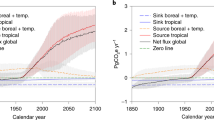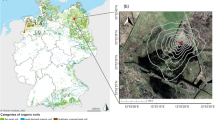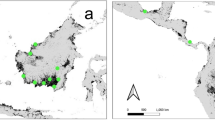Abstract
Context
Globally, the intensive use of peatlands contributes substantially to greenhouse gas emissions. The intensification of peatland use has led to increasing carbon (C) losses over the last centuries, but without historical emissions data, these increases and cumulative emissions are difficult to quantify.
Objectives
To understand the magnitude and development of soil C losses through peatland drainage in Switzerland through time, and to relate the situation of peatlands today to this historical development.
Methods
Historical records and a published estimate of the peatland extent are used to estimate peatlands’ original extent and C stocks, and to understand trends in the historical use of peatlands. Land use-specific emission factors are applied to estimate the C emission through drainage over the last 300 years.
Results
Ca. 15 to 55 Mt C have been lost through peatland drainage in Switzerland. Despite a decrease in the area of organic soils, annual C emissions have increased considerably especially since the mid-twentieth century due to intensification of their use, particularly for agriculture. This C loss is a magnitude greater than that lost through extracted peat. Remaining C stocks approximate those lost over the last 300 years.
Conclusions
The rate of peatland surface loss in Switzerland is typical of European wetlands. Uncertainties in emission factors remain high and should be refined to justify any mitigation strategies. Although peat is no longer mined in Switzerland, future C emissions from peatlands will remain high as long as the effects of drainage networks and their current intensity of use persist.




Similar content being viewed by others
Notes
Federal order on the initiative ‘zum Schutz der Moore - Rothenthurm-Initiative ‘, Art. 24sexies Abs. 5 and UeBest. BV; or Grünig (1994, pp 367–378) for English translation.
https://www.idiotikon.ch/ Accessed 7 February 2017.
This value differs to that reported in the Methods, as modern sites where peat extraction has taken place were excluded from this calculation. This allowed the rate of peat thickness change due to drainage only to be calculated.
References
Anon (1987) Energiestatistik der Schweiz 1910–1985. Bundesamt für Energiewirtschaft/Schweizerisches Nationalkomitee der Weltenergiekonferenz, Bern
Anon (1996) Abklärung des Handlungsbedarfs bezüglich der Nutzung von organischen Böden im Kanton Zürich. Fachstelle Bodenschutz, Zurich
Bader C, Müller M, Schulin R, Leifeld J (2017) Amount and stability of recent and aged plant residues in degrading peatland soils. Soil Biol Biochem 109:167–175
Bader C, Müller M, Schulin R, Leifeld J (2018a) Peat decomposability in managed organic soils in relation to land use, organic matter composition and temperature. Biogeosciences 15:703–719
Bader C, Müller M, Szidat S, Schulin R, Leifeld J (2018b) Response of peat decomposition to corn straw addition in managed organic soils. Geoderma 309:75–83
Béguin J, Smola S (2010) Stand der Drainagen in der Schweiz, Bilanz der Umfrage 2008. Federal Office for Agriculture, Bern
Boscani-Leoni S (2017) Die Debatte um den Torfabbau im 18. Jahrhundert. Die Gebrüder Scheuchzer zwischen Johannes von Muralt und Johann J. Bernoulli. In: Boscani-Leoni S, Stuber M (eds) Wer das Gras wachsen hört. Wissensgeschichte(n) der pflanzlichen Ressourcen vom Mittelalter bis ins 20. Jahrhundert. StudienVerlag, Innsbruck, pp 116–139
Bragg O, Lindsay R, Risager M, Silvius M, Zingstra H (2013) Strategy and action plan for mire and peatland conservation in central Europe. Wetlands International, Wageningen
Byrne KA et al (2004) EU peatlands: current carbon stocks and trace gas fluxes. University of Lund/GeoBiosphere Science Centre, Lund
Charman DJ, Beilman DW, Blaauw M, Booth RK, Brewer S, Chambers FM, Christen JA, Gallego-Sala A, Harrison SP, Hughes PDM, Jackson ST, Korhola A, Mauquoy D, Mitchell FJG, Prentice IC, van der Linden M, De Vleeschouwer F, Yu ZC, Alm J, Bauer IE, Corish YMC, Garneau M, Hohl V, Huang Y, Karofeld E, Le Roux G, Loisel J, Moschen R, Nichols JE, Nieminen TM, MacDonald GM, Phadtare NR, Rausch N, Sillasoo Ü, Swindles GT, Tuittila ES, Ukonmaanaho L, Väliranta M, van Bellen S, van Geel B, Vitt DH, Zhao Y (2013) Climate-related changes in peatland carbon accumulation during the last millennium. Biogeosciences 10:929–944
Conedera M, Vassere S, Neff C, Meurer M, Krebs P (2007) Using toponomy to reconstruct past land use: a case study of ‘brüsada’ (burn) in southern Switzerland. J Hist Geogr 33:729–748
Davidson N (2014) How much wetland has the world lost? Long-term and recent trends in global wetland area. Mar Freshw Res 65:934–941
Derungs C, Wartmann F, Purves RS, Mark DM (2013) The meanings of the generic parts of toponyms: Use and limitations of gazetteers in studies of landscape terms. In: Tenbrink T, Stell J, Galton A, Wood Z (eds) Spatial information theory. COSIT 2013. Lecture notes in computer science. Springer, Cham, pp 261–278
Desaules A, Studer K (1993) Nationales Bodenbeobachtungsnetz: Messresultate 1985–1991. Bundesamt für Umwelt, Wald und Landschaft BUWAL, Bern
Donada JT (2009) Agrarian landscapes and the toponymy of Mediterranean Europe. Catalonia as a case study. In: Ahrens W, Embleton S, Lapierre A (eds) Proceedings of the 23rd international congress of onomastic sciences: names in multi-lingual, multi-cultural and multi-ethnic contact. York University, 2008. York University, Toronto, pp 976–988
Erkens G, van der Meulen MJ, Middelkoop H (2016) Double trouble: subsidence and CO2 respiration due to 1,000 years of Dutch coastal peatlands cultivation. Hydrogeol J 24:551–568
Ewald K, Klaus G (2010) Die ausgewechselte Landschaft, 2nd edn. Haupt, Bern
Fenner S (2007) Torfeigenschaften und Moorsackungsraten von landwirtschaftlich genutzten Böden im Gebiet Witzwil. Diploma Thesis, University of Zurich
FOEN (2017) Switzerland’s greenhouse gas inventory 1990–2015: National inventory report 2017. Federal Office for the Environment, Bern
Früh J, Schröter C (1904) Die Moore der Schweiz mit Berücksichtigung der gesamten Moorfrage. Beiträge zur Geologie der Schweiz herausgegeben von der geologischen Kommission der Schweiz. naturforschenden Gesellschaft. A. Francke, Bern
Gimmi U, Lachat T, Bürgi M (2011) Reconstructing the collapse of wetland networks in the Swiss lowlands 1850–2000. Landsc Ecol 26:1071–1083
Grünig A (ed) (1994) Mires and man: mire conservation in a densely populated country: the Swiss experience. Swiss Federal Institute for Forest, Snow and Landscape Research, WSL, Birmensdorf
Grünig A, Vetterli L, Wildi O (1986) Die Hoch- und Übergangsmoore der Schweiz, vol 281. Eidgenössische Anstalt für das forstliche Versuchswesen, Birmensdorf
Gubler L (2009) Kohlenstoffverlust aus entwässerten Schweizer Hochmooren. Master’s thesis, University of Bern
Hirt H (2007) Torfstechen im Seeland: Gewinnung des Rohstoffes Torf bei Energieversorgungslücken seit dem 18. Jahrhundert. Bern Z Gesch Heimatkunde 69:39–76
Hürlimann K (2016) Agrarintensivierung - aus Wald wird Feld und Wiese. In: Mathieu J, Backhaus N, Hürlimann K, Bürgi M (eds) Geschichte der Landschaft in der Schweiz: Von der Eiszeit bis zur Gegenwart. Orell Füssli, Zurich, pp 78–90
IPCC (2006) 2006 IPCC guidelines for national greenhouse gas inventories. Volume 4, agriculture, forestry and other land use. Chapter 10. Institute for Global Environmental Strategies IGES, Japan
IPCC (2014) 2013 Supplement to the 2006 IPCC guidelines for national greenhouse gas inventories (Chap. 2). Wetlands. IPCC, Switzerland
Joosten H, Clarke D (2002) Wise use of mires and peatlands. International Mire Conservation Group, Greifswald, Germany/International Peat Society, Jyväskylä
KIAA (1941) Bericht über die Erhebungen vom Herbst 1941 in den wichtigsten Moorgebieten der Schweiz, deren Torflager für die Torfverkohlung- Destillation- und Brikettierung in Betracht fallen können. Kriegs- Industrie- und Arbeitsamt, Sektion für Holz, Gruppe Torf, Bern. Swiss Federal Archives E7389_1000_1106_907
Klaus G (ed) (2007) Zustand und Entwicklung der Moore in der Schweiz. Federal Office for the Environment FOEN, Bern
Kluge B, Wessolek G, Facklam M, Lorenz M, Schwärzel K (2008) Long-term carbon loss and CO2–C release of drained peatland soils in northeast Germany. Eur J Soil Sci 59:1076–1086
Küchler M, Küchler H, Bergamini A, Bedolla A, Ecker K, Feldmeyer-Christe E, Graf U, Holderegger R (2018) Moore der Schweiz: Zustand, Entwicklung, Regeneration. Bristol-Stiftung, Zurich
Kuster A (1946) Die Torfproduktion während des zweiten Weltkrieges. Swiss For J 97:257–258
Leiber-Sauheitl K, Fuß R, Voigt C, Freibauer A (2014) High CO2 fluxes from grassland on histic Gleysol along soil carbon and drainage gradients. Biogeosciences 11:749–761
Leifeld J, Gubler L, Grünig A (2011a) Organic matter losses from temperate ombrotrophic peatlands: an evaluation of the ash residue method. Plant Soil 341:349–361
Leifeld J, Menichetti L (2018) The underappreciated potential of peatlands in global climate change mitigation strategies. Nat Commun 9:1–7
Leifeld J, Müller M, Fuhrer J (2011b) Peatland subsidence and carbon loss from drained temperate fens. Soil Use Manag 27:170–176
Leifeld J, Steffens M, Galego-Sala A (2012) Sensitivity of peatland carbon loss to organic matter quality. Geophys Res Lett 39:1–6
Lienert B (2013) Einfluss von Aufforstung auf Kohlenstoffverluste aus organischen Böden (Halbmooren) im Staatswald bei Witzwil (BE). Master’s thesis, University of Zurich
Loisel J, Yu ZC, Beilman DW, Camill P, Alm J, Amesbury MJ, Anderson D, Andersson S, Bochicchio C, Barber K, Belyea LR, Bunbury J, Chambers FM, Charman DJ, De Vleeschouwer F, Fialkiewicz-Koziel B, Finkelstein SA, Galka M, Garneau M, Hammarlund D, Hinchcliffe W, Holmquist J, Hughes P, Jones MC, Klein ES, Kokfelt U, Korhola A, Kuhry P, Lamarre A, Lamentowicz M, Large D, Lavoie M, MacDonald G, Magnan G, Makila M, Mallon G, Mathijssen P, Mauquoy D, McCarroll J, Moore TR, Nichols J, O'Reilly B, Oksanen P, Packalen M, Peteet D, Richard PJH, Robinson S, Ronkainen T, Rundgren M, Sannel ABK, Tarnocai C, Thom T, Tuittila ES, Turetsky M, Valiranta M, van der Linden M, van Geel B, van Bellen S, Vitt D, Zhao Y, Zhou W (2014) A database and synthesis of northern peatland soil properties and Holocene carbon and nitrogen accumulation. Holocene 24:1028–1042
Lüdi W (1973) Moore der Schweiz, vol 1–10. Schweizerischer Bund für Naturschutz, Pro Natura, Basel
Mühlethaler E (1995) Nutzungsgeschichte der Hoch- und Übergangsmoore. In: Bressoud B et al (eds) Handbuch Moorschutz in der Schweiz 1 (Chap. 3.2.4), vol 1. Bundesamt für Umwelt, Wald und Landschaft BUWAL, Bern, pp 1–12
Pärn J, Verhoeven JTA, Butterbach-Bahl K, Dise NB, Ullah S, Aasa A, Egorov S, Espenberg M, Järveoja J, Jauhiainen J, Kasak K, Klemedtsson L, Kull A, Laggoun-Défarge F, Lapshina ED, Lohila A, Lõhmus K, Maddison M, Mitsch WJ, Müller C, Niinemets Ü, Osborne B, Pae T, Salm J-O, Sgouridis F, Sohar K, Soosaar K, Storey K, Teemusk A, Tenywa MM, Tournebize J, Truu J, Veber G, Villa JA, Zaw SS, Mander Ü (2018) Nitrogen-rich organic soils under warm well-drained conditions are global nitrous oxide emission hotspots. Nat Commun 9:1135
Presler J, Gysi C (1989) Organische Böden des schweizerischen Mittellandes. Nationales Forschungsprogramm, Liebefeld-Bern
Probst E, Schmidlin H, Zimmerli N (1923) Die Torfausbeutung in der Schweiz in den Jahren 1917 bis 1921, Vol 1 and 2. Eidgenössische Inspektion für Forstwesen, Jagd und Fischerei, Bern
SFSO (2004–2009) Swiss land use statistics (Arealstatistik 2004/09). Swiss Federal Statistical Office, Neuchâtel
Smith P, Martino D, Cai Z, Gwary D, Janzen H, Kumar P, McCarl B, Ogle S, O'Mara F, Rice C, Scholes B, Sirotenko O, Howden M, McAllister T, Pan G, Romanenkov V, Schneider U, Towprayoon S, Wattenbach M, Smith J (2008) Greenhouse gas mitigation in agriculture. Philos Trans R Soc B 363:789–813
Stamm A (1919) Die Torfausbeutung in der Schweiz. Schweiz Tech Ztg 27(28):137–141
Strüby A (1947) Das außerordendiche Meliorationsprogramm. Bericht über das Meliorationswesen der Schweiz 1940–1946. Eidgenösschiches Meliorationsamt, Bern
Stuber M, Bürgi M (2018) Vom “eroberten Land” zum Renaturierungsprojekt. Geschichte der Feuchtgebiete in der Schweiz seit 1700. Bristol-Stiftung, Zurich
Swisstopo (2017) SwissNAMES3D, 2016th edn. Federal Office of Topography, Bern
Thut W (1996) Drainröhren - ihre Entwicklung und Verbreitung : ein Beitrag zur Technikgeschichte der Landwirtschaft mit spezieller Berücksichtigung der Schweiz. Diploma thesis, University of Bern
Tiemeyer B, Albiac Borraz E, Augustin J, Bechtold M, Beetz S, Beyer C, Drösler M, Ebli M, Eickenscheidt T, Fiedler S, Förster C, Freibauer A, Giebels M, Glatzel S, Heinichen J, Hoffmann M, Höper H, Jurasinski G, Leiber-Sauheitl K, Peichl-Brak M, Roßkopf N, Sommer M, Zeitz J (2016) High emissions of greenhouse gases from grasslands on peat and other organic soils. Glob Chang Biol 22:4134–4149
von Knonau GM (1844) Gemälde der Schweiz. Der Kanton Zürich. Huber und Compagnie, St Gallen
Wilson D, Blain D, Couwenberg J, Evans CD, Murdiyarso D, Page SE, Renou-Wilson F, Rieley JO, Sirin A, Strack M, Tuittila E-S (2016) Greenhouse gas emission factors associated with rewetting of organic soils. Mires Peat 17:1–28
Wüst-Galley C, Grünig A, Leifeld J (2015) Locating organic soils for the Swiss greenhouse gas inventory. Agroscope Sci 26:1–100
Wüst-Galley C, Mössinger E, Leifeld J (2016) Loss of the soil carbon storage function of drained forested peatlands. Mires Peat 18:1–22
Zeitz J (1997) Zur Geochemie von Mooren. In: Matschullat T, Tobschall HJ, Voigt HJ (eds) Geochemie und Umwelt. Relevante Prozesse in Atmo-, Pedo- und Hydrosphäre. Springer, Berlin, pp 75–94
Zimmerli N (1944) Die Torfausbeutung in der Schweiz. Swiss For J 95:108–110
Acknowledgements
This work was part-funded by the Swiss Federal Office for the Environment.
Author information
Authors and Affiliations
Corresponding author
Additional information
Publisher's Note
Springer Nature remains neutral with regard to jurisdictional claims in published maps and institutional affiliations.
Electronic supplementary material
Below is the link to the electronic supplementary material.
Rights and permissions
About this article
Cite this article
Wüst-Galley, C., Grünig, A. & Leifeld, J. Land use-driven historical soil carbon losses in Swiss peatlands. Landscape Ecol 35, 173–187 (2020). https://doi.org/10.1007/s10980-019-00941-5
Received:
Accepted:
Published:
Issue Date:
DOI: https://doi.org/10.1007/s10980-019-00941-5




